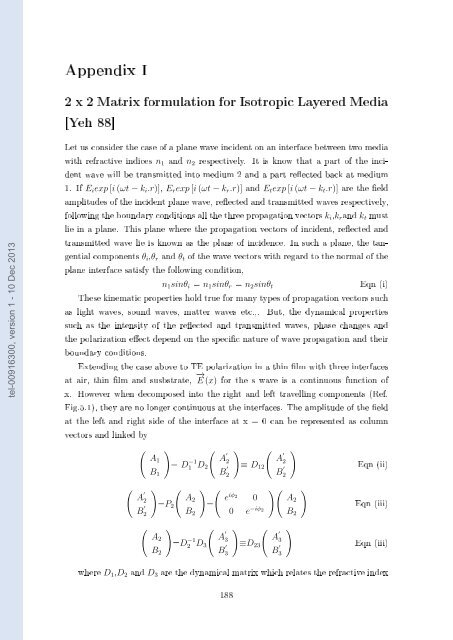Films minces à base de Si nanostructuré pour des cellules ...
Films minces à base de Si nanostructuré pour des cellules ...
Films minces à base de Si nanostructuré pour des cellules ...
Create successful ePaper yourself
Turn your PDF publications into a flip-book with our unique Google optimized e-Paper software.
Appendix I<br />
2 x 2 Matrix formulation for Isotropic Layered Media<br />
[Yeh 88]<br />
tel-00916300, version 1 - 10 Dec 2013<br />
Let us consi<strong>de</strong>r the case of a plane wave inci<strong>de</strong>nt on an interface between two media<br />
with refractive indices n 1 and n 2 respectively. It is know that a part of the inci<strong>de</strong>nt<br />
wave will be transmitted into medium 2 and a part reected back at medium<br />
1. If E i exp [i (ωt − k i .r)], E r exp [i (ωt − k r .r)] and E t exp [i (ωt − k t .r)] are the eld<br />
amplitu<strong>de</strong>s of the inci<strong>de</strong>nt plane wave, reected and transmitted waves respectively,<br />
following the boundary conditions all the three propagation vectors k i ,k r and k t must<br />
lie in a plane. This plane where the propagation vectors of inci<strong>de</strong>nt, reected and<br />
transmitted wave lie is known as the plane of inci<strong>de</strong>nce. In such a plane, the tangential<br />
components θ i ,θ r and θ t of the wave vectors with regard to the normal of the<br />
plane interface satisfy the following condition,<br />
n 1 sinθ i = n 1 sinθ r = n 2 sinθ t<br />
Eqn (i)<br />
These kinematic properties hold true for many types of propagation vectors such<br />
as light waves, sound waves, matter waves etc.,. But, the dynamical properties<br />
such as the intensity of the reected and transmitted waves, phase changes and<br />
the polarization eect <strong>de</strong>pend on the specic nature of wave propagation and their<br />
boundary conditions.<br />
Extending the case above to TE polarization in a thin lm with three interfaces<br />
at air, thin lm and susbstrate, −→ E (x) for the s wave is a continuous function of<br />
x. However when <strong>de</strong>composed into the right and left travelling components (Ref.<br />
Fig.5.1), they are no longer continuous at the interfaces. The amplitu<strong>de</strong> of the eld<br />
at the left and right si<strong>de</strong> of the interface at x = 0 can be represented as column<br />
vectors and linked by<br />
(<br />
(<br />
A ′ 2<br />
B ′ 2<br />
(<br />
) (<br />
A 1<br />
= D1 −1 D 2<br />
B 1<br />
)=P 2<br />
(<br />
) (<br />
A 2<br />
=<br />
B 2<br />
) (<br />
A 2<br />
=D2 −1 D 3<br />
B 2<br />
A ′ 2<br />
B ′ 2<br />
A ′ 3<br />
B ′ 3<br />
)≡ D 12<br />
(<br />
e iφ 2<br />
0<br />
0 e −iφ 2<br />
)≡D 23<br />
(<br />
A ′ 2<br />
B ′ 2<br />
)(<br />
A ′ 3<br />
B ′ 3<br />
)<br />
)<br />
A 2<br />
B 2<br />
)<br />
Eqn (ii)<br />
Eqn (iii)<br />
Eqn (iii)<br />
where D 1 ,D 2 and D 3 are the dynamical matrix which relates the refractive in<strong>de</strong>x<br />
188
















